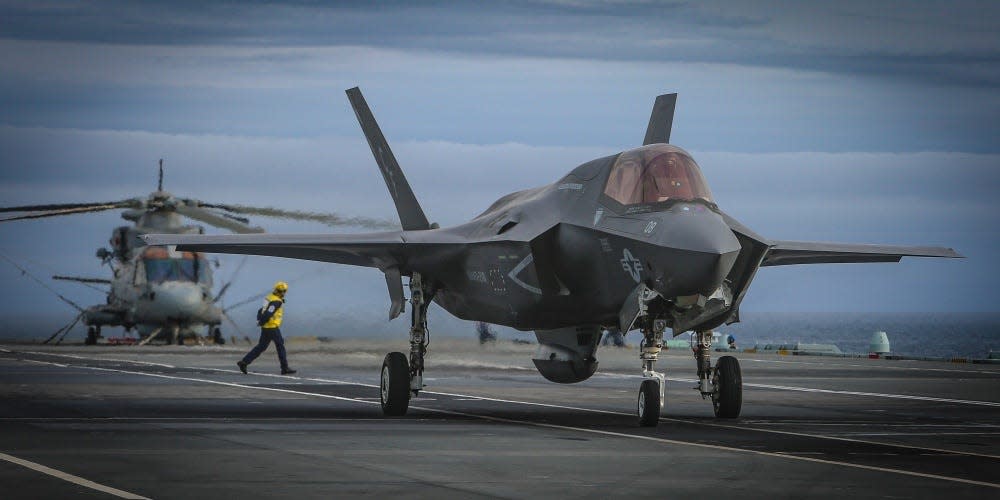A Marine Corps F-35 was damaged by a round fired from the fighter's own cannon that exploded

A Marine Corps F-35B was damaged by a round fired from its own gun earlier this month.
The 25 mm round exploded after it left the F-35Bs externally-mounted 25 mm GAU-22/A Gatling gun.
The incident was a severe mishap, but the aircraft landed safely and no one was injured.
A US Marine Corps F-35B Lighting II Joint Strike Fighter was damaged earlier this month after a round fired from its own cannon exploded, Military.com first reported.
On March 12, the fifth-generation fighter was conducting a nighttime close air support mission on a range at Marine Corps Air Station Yuma in Arizona. During a gunnery exercise, a 25mm Semi-Armor Piercing High Explosive Incendiary-Tracer (SAPHEI-T) round fired from its cannon exploded, causing fragmentation damage to the fuselage.
The incident was classified as a "Class A' mishap, according to the Naval Safety Center. A Class A mishap, the most severe of the four aircraft mishap classifications, means at least $2.5 million in damages.
Despite the damage to the fighter when the round exploded, the aircraft landed safely, according to the Naval Safety Center. Marine Corps spokesman Capt. Andrew Wood said in a statement "the mishap did not result in any injury to personnel."
The F-35B is one of three F-35 variants. The F-35B, a short takeoff/vertical landing (STOVL) variant, can fight from airstrips on land and amphibious assault ships at sea. Like the carrier-based F-35C, it is equipped with an externally-mounted gun pod.
The Air Force F-35As have an internal gun.
All three F-35 variants are equipped, in one configuration or another, with a 25 mm GAU-22/A four-barrel Gatling gun, which is capable of firing over 3,000 rounds a minute. With just 220 rounds, an F-35B pilot can empty the magazine in about 4 seconds. A tracer round leaves a visual trail a pilot can use to track it and potentially adjust fire.
It is unclear why the round fired from the gun on March 12 exploded after leaving the barrel, but the incident is currently under investigation.
The internally-mounted guns on the F-35A have been more problematic. For instance, the Pentagon's testing and evaluation office reported last January that not only was the cannon inaccurate, but its use caused troubling cracking.
The first live-fire test of the externally-mounted podded GAU-22A cannon on an F-35B was conducted in 2016, just one year after the aircraft achieved initial operational capability.
A Marine Corps F-35B was the first F-35 to fly into combat, launching from the amphibious assault ship USS Essex to conduct strikes against the Taliban in Afghanistan in 2018.
The F-35 Joint Strike Fighter is the most expensive weapon program in US military history, and questions have been raised repeatedly about the value of the program given various developmental setbacks.
Earlier this month, Rep. Adam Smith, a Democrat from Washington and the chairman of the House Armed Service Committee, said he wants to "stop throwing money down that particular rathole," referring to the F-35. "What does the F-35 give us? And is there a way to cut our losses?" he asked.
The estimated lifetime cost of the F-35 is currently around $1.7 trillion.
The military has, however, frequently defended the F-35.
In 2019, the commanding officer of the 31st Marine Expeditionary Unit stated that "the F-35B defines shock and awe." Praising the fifth-generation aircraft, he said that "the speed that we can conduct precision strikes with devastating effects while providing close air support to our Marines is nothing shy of awesome."
Read the original article on Business Insider

